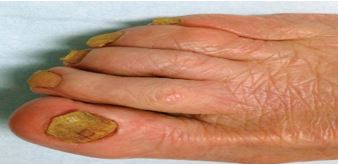A scientific review on Dadrukushta with special reference to Dermatophytosis and its management through Ayurveda
DOI:
https://doi.org/10.21760/jaims.8.5.7Keywords:
Kushta, Dadrukushta, Dermatophytosis, Ayurveda, Skin, FungalAbstract
Skin is the largest organ of the body and skin diseases has a high prevalence throughout the world and fungal infection of skin is one of them. In the high populated countries like India and China the incidence of skin diseases is considerably increased in recent years due to predisposing factors like warm, humid climate, crowded living conditions, hygiene and poor nutrition. In Ayurveda all the skin related diseases are explained under main heading of Kushta and skin fungal infections termed as Dadrukushta (Dermatophytosis). Ayurveda has a versatile approach towards skin disorders depending on the requirement of the patient. The present article is aimed at understanding the disease Dadrukushta with special reference to Dermatophytosis and its management through Ayurveda.
Downloads
References
Madhava Nidhana – by Madhavakara, Madhukosha Sanskrit commentary by shri Vijayrakshita, Shrikanthadatta and Vidyotini Hindi commentary by Y.N Upadhyaya Chaukamba Sanskrit Sansthan, Varanasi Kushtanidhan 49 page no.625, shlok no.20/10-16, part 2
Shastri kashinatha et.al, charaka samhita, chaukambha Sanskrit sansthan Varanasi, edition reprint 2012, chikitsa sthana 7/30, page no.204
Shastri ambikadatta, sushruta samhita, chaukamba Sanskrit sansthan Varanasi, fourth edition 1976, nidana sthana 5/5, page no.247
Agnivesha, Charaka Samhita with Ayurveda Dipika Commentary edited by Vaidya Yadavji Trikamji Acharya; Chaukambha Orientalia, Varanasi-2004; Chikitsasthana, Chapter no.7, Shlok no.30, page no.204
Murty Shrikantha K.R., Ashtanga Hridaya; 2nded., Chaukambha Sanskrit Sansthana, Varanasi-1995; Nidhanasthana, Chapter no.14, Shlok no.9, page no.137
Ambika Dutt Shastri, Sushruta Samhita; Reprint, Chaukamba Sanskrit Sansthan, Varanasi-2014; Nidhanasthana, Chaper no.5, Shlok no.8, page no.248
Golwalla’s MEDICINE for students, by Dr.Aspi F. Golwalla, Dr.Sharukh A. Golwalla., Edited by Dr.Milind Y. Nadkar., 25th Edition-2017., Jaypee Brothers Medical Publications; Chapter 15; page no.923
Monsoon’s Tropical Diseases – Edited by Gordon C. Cook & Alimuddin Zumla, Saunders Elsevier Science, 21st edition;2003; Chapter – 69, by R.J Hay, page no. 1173-1176.
Harrison’s principle of internal medicine, vol-1,edition 18, chapter 52, page no.401
Ronald Marks, Roxburgh’s common skin diseases, edition 16, chapter 4, page no.33
Harrison’s Principles Of Internal Medicine, edited by Fauci, Braunwald, Kasper, Hauser, Longo, Jameson, Loscalzo, 17th edition, Vol-2, Chapter no.199 Page no.1264.
Ronald Marks. Roxburgh’s Common skin diseases, Chapter – 11; 7th edition, Arnold, London, 2003:3. www.jaims.in
Harsh Mohan Textbook of Pathology, 7th edition:2015, Jaypee Brothers Medical Publishers (P) Ltd; chapter no.24; page no.764
Puripanda s kamalakar et.al, understanding the concept of sankramika dadru kusta-a case study, intrernational journal of ayurveda and pharma research, August, 2016; 4(8): 81-85.
Shastri ambikadutta, susrutasamhita, chaukhambha Sanskrit sansthan varanasi, fourth edition, nidana sthana, 1976; 5/32- 33, 325.
Shastri kasinatha et.al, charaka samhita, chaukhambha Sanskrit sansthan Varanasi, edition: reprint, chikitsa sthana, 2012; 7/4- 8: 201.
Shastri ambikadutt, susrutasamhita, chaukhambha Sanskrit sansthan varanasi, edition: reprint, nidana sthana, 5/3: 246.
Katyayan abhay, bhela samhita, chaukhambha surbharti prakashan varanasi, first edition 2009, nidana sthana 5/1-4, 160.
Tripathi pandit hariprasad, harita samhita, chowkhamba Krishnadas academy varanasi, edition, 2005, tritiya sthana 39/1-2, 415.
Vijayaraksita & datta srikantha et.al. madhava nidanam, chaukhambha surbharti prakashan Varanasi, 2, edition reprint, kushta nidanam 49/1-6, 2011; 194.
Harrison’s principle of internal medicine, vol-1, edition 18, chapter, 52, 401.















